Our senses- touch, taste, sound, sight and smell – create a tapestry of our world turning it into a beautiful, multi-layered experience. The Legacy Garden strives to create that experience by involving our senses throughout the year. Often, we think that the garden is “dead” in the winter and there isn’t much to look at until spring and summer. Hopefully, this garden will show you that that doesn’t have to be the case. Using different aspects of the plants such as bark, berries, plant structure, fragrance, leaves, flowers, there should always be something to delight your senses in the Legacy Garden. And why shouldn’t there be something that catches our eye and gladdens our heart even in the dead of winter?
Think about a plant’s bark
Have you looked at the Stewartia psuedocamellia (OL06)? This wonderful tree has the most amazing bark. And if that isn’t enough to love about the tree it also blooms in the summer with white camellia-like flowers. Or what about the dwarf artic willow (Salix purpurea ‘Nana’, OL10)? This easy-to-grow shrub has a purplish tinge to its branches.
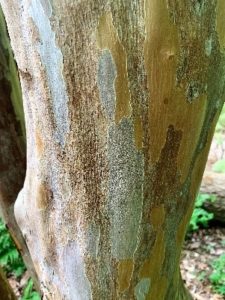
Bark of Stewartia
Berries that catch your eye.
If you visit the garden in the fall you can’t miss the glossy violet-purple berries that line the branches of beautyberry (Callicarpa bodinieri var. giraldii ‘Profusion’, OL10) – they are a show stopper. Or what about Harlequin glorybower (Clerodendron trichotomum, OL09)? This small tree starts out with fragrant white flowers that are followed by bright blue berries surrounded by a fleshy red calyx. A little horticultural language that means a stunning eyecatcher of blue and red to hot pink in the fall. And for an added treat the leaves when crushed smell a bit like peanut butter. Some of us love the smell and some are a bit put off by it. And if we’re going to talk about berries we must mention the American Holly (Ilex opaca ‘Canary’, OL10). This evergreen shrub shows off bright yellow berries during the winter.
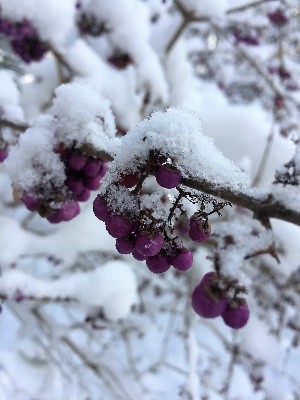
Beautyberry 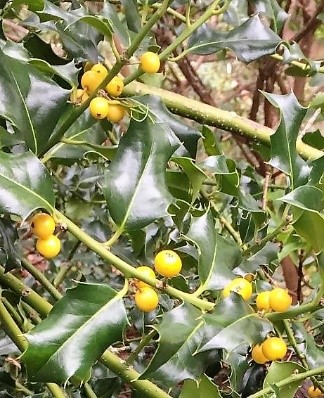
American Holly
Interesting structures.
Sometimes a plant can contribute to the garden simply because of its structure. One plant that fits this bill is known as Harry Lauder’s Walking Stick (Corylus avellana ‘Contorta’, OL09). I have no idea why this plant was named after Harry Lauder, a Scottish entertainer in the early 1900s, or who could possibly make a walking stick out of one of the branches but I do know that it has some of the most interesting gnarled and twisted branches you’ll ever see. And for that reason, it grabs your eye and puts a smile on your face anytime of the year. Another interesting (or weird) plant to look for is the crested Japanese cedar (Cryptomeria japonica ‘Cristata’, OL09). This evergreen’s eye-catching trait is the odd, congested growth at its tips that seems slightly reminiscent of a rooster’s cockscomb. This plant’s structure can certainly catch your eye and make you go “Hmm?”
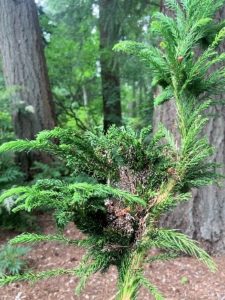
Cryptomeria japonica ‘Cristata’
Stop and smell.
In the plant world, fragrance is often subtle, it doesn’t grab you but softly fills the air and creates an atmosphere that we often miss if we are rushing through a space. The saying “Stop and smell the roses” could be re-stated as “Slow down, close your eyes and experience this moment in the garden.” There are some plants that everyone thinks of when you talk about smell – such as roses. But what about Fragrant sweet box (Sarcococca ruscifolia, OL08a)? Some of us might appreciate this plant for its compact evergreen presence but in early spring the small white flowers release a delightful perfume of sweet vanilla. And what about the stately Southern magnolia (Magnolia grandiflora ‘Edith Bogue’, OL11)? This beautiful evergreen magnolia shares its lemon-scented white flowers in early summer. You know that Lonicera fragrantissima (OL02), Fragrant honeysuckle, has to have a fragrance when its in its name. Before the leaves of this deciduous shrub emerge in spring, this plant sports small, white, extremely fragrant flowers. One plant that most people don’t think about when you talk about fragrance is lily of the valley (Convallaria majalis, OL09). This low-growing spreading woodland plant sends up an arching stem with a sweetly fragrant white flower in the spring. And if that isn’t enough there are lilacs, roses and peonies throughout the garden as well.
Leaves of all shapes and sizes.
The Legacy Garden begs you to really look at leaves. The giant leatherleaf viburnum (Vibnurnum rhytidiphyllum, OL08) has large, thickly-textured, almost leather-like leaves all year long. For the biggest leaves, look for the bigleaf magnolia (Magnolia macrophylla, OL05 and OL10) whose leaves can be 19 – 35” long. This tree boasts the largest simple leaf and single flower of any native plant in North America. Contrast those leaves with the thin, strappy leaves (less than a ¼” wide) of Rhododendron stenopetalum ‘Linearifolium’ (OL10). The spiderleaf rhodie looks nothing like what you picture a rhododendron to look like. For more fun with rhododendron leaves, look for R. ‘Teddy Bear’ (OL10) whose leaves are a glossy dark green with teddy bear brown indumentum (fuzzy “hairs” on the underside of a leaf) or R. bureavii (OL11) whose thick wooly indumentum turns a rusty red with age. There are also many shrubs that have colorful foliage, such as Leucothoe fontanesiana ‘Rainbow’ (OL10), Osmanthus heterophyllus ‘Goshiki’ (OL02), and Pieris japonica ‘Variegata’ (OL06) and Rhododendrdon ponticum ‘Variegatum’ (OL11). Some shrubs will have great foliage in the spring, such as Corylus maxima ‘Purpurea’ (OL09) with deep purple leaves which do dull out a bit over the summer. Or there is the fall foliage show put on by the sourwood tree, Oxydendron arboreum (OL10), donning itself in bright crimson leaves which are really shown off if it is still holding on to its late-summer white flowers.
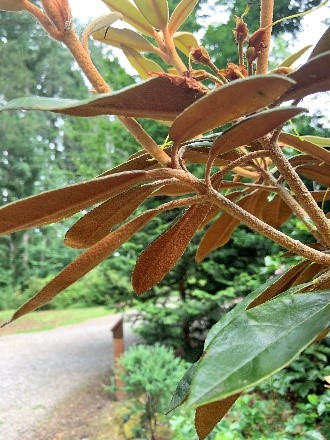
Rhod. ‘Teddy Bear’ 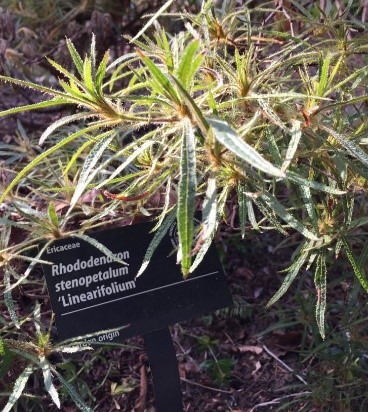
Rhod. Stenopetalum Linearifolium 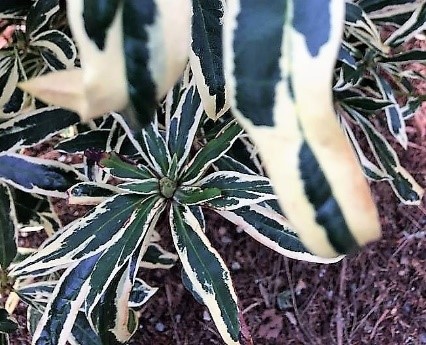
Rhod. Ponticum Variegatum 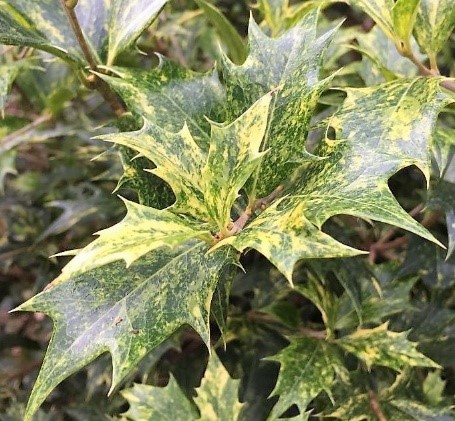
Osmanthus heterophyllus Goshiki 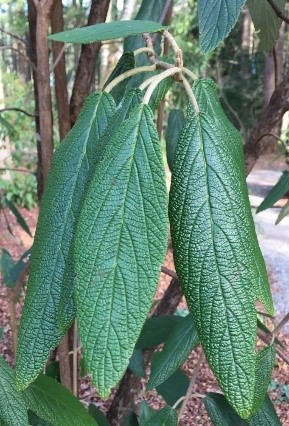
Leatherleaf Viburnum 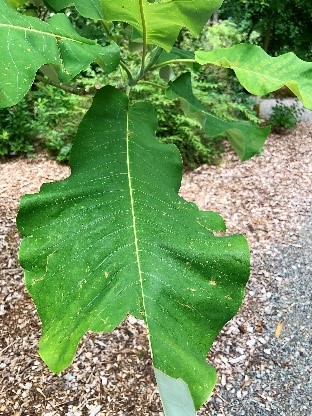
Bigleaf Magnolia
We can’t forget the flowers.
When you talk about delighting the senses, you must talk about the flowers. Almost every month of the year you can find something in bloom in this garden. Don’t miss the variety of hellebores in the winter/early spring, followed by Camellias, Winterhazel (Corylopsis spicata, OL02), a variety of azaleas and rhododendrons, peonies, lilacs, and magnolias. A few you really should look for because of their unexpected nature are Pink Dawn Viburnum (Viburnum x bodnantense ‘Pink Dawn, OL04) which blooms in the winter and early spring, sometimes as early as December, and the bright orange flowers of the evergreen barberry (Berberis darwinii, OL09) around March.
